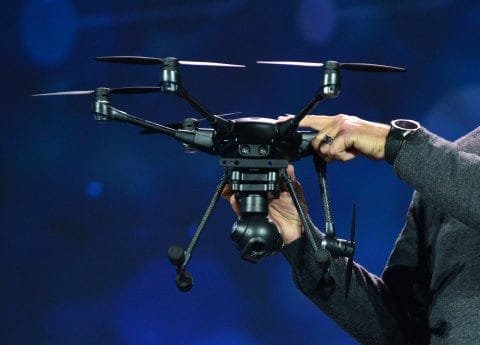
Earlier last year, Intel acquired Ascending Technologies, a German company responsible for the development of algorithms and software for the sense and avoid technology called RealSense: “The world’s first, integrated 3D depth and 2D camera module that helps see depth much like the human eye” (Heater, 2016), RealSense allows a small UAS the means to sense and avoid obstacles in a dynamic environment. Championed as “the world’s most advanced collision-avoidance system for consumer drones” (Kaplan, 2016), the first commercial application of this technology, the RealSense R200 camera, applied on the Typhoon-H UAV, began selling preorders in June of 2016. I think that RealSense is the ideal sense and avoid technology for small unmanned aerial systems (sUAS), today.
Due to the variety of application and capabilities, including face recognition, gesture detection, 3D object scans, and foreground and background recognition, RealSense technology is applicable not only to sUAS but also a variety of other handheld or portable devices including tablets and laptops. For the purpose of sense and avoid in unmanned systems, in a recent demonstration, Intel used a configuration of six R200 cameras arranged in a hexagonal shape to achieve 360 degree sight and obstacle avoidance (Ulanoff, 2015). The R200 sensor hardware has a small enough signature to fit six onto an average sized sUAS. Each R200 is approximately 102 x 9.5 x 3.8 mm in size and is comprised of 3 cameras that integrate RGB and stereoscopic IR to produce depth perception. The R200 sensor has an inside range of 0.5-3.5 meters and an outside range of up to 10 meters (Culbertson, 2015) and draws 0-100mw when idle to 1.0-1.6 watts when not idle. The RGB (color) camera is capable of 32 bit RGBA at 1080p at 60 FPS and The class 1 laser of the IR camera is in the 850nm range (Culbertson).
The color camera provides images for human perception, “and the two [stereoscopic IR] depth cameras provide the data for algorithmic consumption” (Culbertson). The camera builds a three dimensional digital representation of its surroundings and estimates its position in real time. Using triangulation, depth is determined by the disparity between the two IR cameras (Culbertson, 2015).
RealSense is an exciting & intuitive sense and avoid technology, soon to be readily available on both the Yuneec Typhoon H UAV or for individual purchase to integrate onto other small UAS (Goldman, 2016). The hardware itself has a small size, weight, and power (SWaP) signature, perfect for sUAS with SWaP limitations. This technology will allow UAVs to travel naturally through dynamic, obstacle filled environments, autonomously avoiding objects in real time and determining and finding the best path to compliment human commands. If a human operator controls his UAV into a dense forest, RealSense will prevent the UAV from crashing into trees while staying true to the desired travel, even stopping to avoid real time dynamic obstructions, like falling trunks and branches, and continuing on around the obstacles.
References:
Culbertson, C. (2015). Introducing the Intel® RealSense™ R200 Camera (world facing) | Intel®
Software. Software.intel.com. Retrieved 17 July 2016, from https://software.intel.com/en-us/articles/realsense-r200-camera
Goldman, J. (2016). Yuneec Typhoon H drone gets new obstacle-avoiding powers from Intel.
CNET. Retrieved 18 July 2016, from http://www.cnet.com/news/yuneec-typhoon-h-drone-gets-new-obstacle-avoiding-powers-from-intel/
Heater, B. (2016). Intel unveils RealSense hardware and software line, including 3D camera
module. Engadget. Retrieved 17 July 2016, from https://www.engadget.com/2014/01/06/intel-realsense/
Kaplan, K. (2016). Drone with RealSense Can See Like Humans. iQ by Intel. Retrieved 17 July
2016, from https://iq.intel.com/new-era-for-smart-drones-that-can-see/
Ulanoff, L. (2015). Intel wants to put RealSense everywhere, even on drones. Mashable.
Retrieved 17 July 2016, from http://mashable.com/2015/09/02/intel-realsense-drones/#5sf4Ep29eGq2
Write good